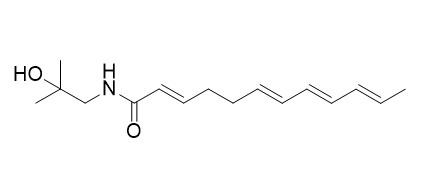Hydroxy-beta-sanshool
Hydroxy-β-sanshool is a pungent compound, it can cause oral numbness.
Inquire / Order:
manager@chemfaces.com
Technical Inquiries:
service@chemfaces.com
Tel:
+86-27-84237783
Fax:
+86-27-84254680
Address:
1 Building, No. 83, CheCheng Rd., Wuhan Economic and Technological Development Zone, Wuhan, Hubei 430056, PRC
Providing storage is as stated on the product vial and the vial is kept tightly sealed, the product can be stored for up to
24 months(2-8C).
Wherever possible, you should prepare and use solutions on the same day. However, if you need to make up stock solutions in advance, we recommend that you store the solution as aliquots in tightly sealed vials at -20C. Generally, these will be useable for up to two weeks. Before use, and prior to opening the vial we recommend that you allow your product to equilibrate to room temperature for at least 1 hour.
Need more advice on solubility, usage and handling? Please email to: service@chemfaces.com
The packaging of the product may have turned upside down during transportation, resulting in the natural compounds adhering to the neck or cap of the vial. take the vial out of its packaging and gently shake to let the compounds fall to the bottom of the vial. for liquid products, centrifuge at 200-500 RPM to gather the liquid at the bottom of the vial. try to avoid loss or contamination during handling.
LWT-Food Science and Technology2017, 75:488-496
Molecules.2019, 24(17):E3127
Molecules.2022, 27(7):2116.
J Cell Mol Med.2024, 28(16):e70016.
Microchemical Journal2014, 203:110804.
Antioxidants2022, 11(2),234.
Vietnam Journal of Science2022, 64(2), 69-75.
Int J Mol Sci.2023, 24(24):17589.
Pharmacogn J.2022, 14(2):350-357
Academic J of Second Military Medical University2018, 39(11)
Related and Featured Products
J Agric Food Chem. 2018 Jun 6;66(22):5621-5634.
Dynamic Proteome Alteration and Functional Modulation of Human Saliva Induced by Dietary Chemosensory Stimuli.[Pubmed:
29787679 ]
METHODS AND RESULTS:
Saliva flow measurements and SDS-PAGE separation of human whole saliva freshly collected after oral stimulation with citric acid (sour), aspartame (sweet), iso-α-acids (bitter), mono sodium l-glutamate (umami), NaCl (salty), 6-gingerol (pungent), hydroxy-α-sanshool (tingling), and Hydroxy-beta-sanshool (numbing), followed by tryptic digestion, nano-HPLC-MS/MS, and label-free protein quantitation demonstrated a stimulus- and time-dependent influence of the dietary chemosensates on salivation and the salivary proteome composition. Gene ontology enrichment analysis showed evidence for stimulus-induced alterations of the saliva proteome to boot an efficient molecular defense network of the oral cavity, e.g., 6-gingerol increased salivary lactoperoxidase activity, catalyzing the oxidation of thiocyanate to produce the antimicrobial and antifungal hypothiocyanate, from 0.37 ± 0.02 to 0.91 ± 0.05 mU/mL 45 s after stimulation. In comparison, oral citric acid stimulation induced an increase of myeloperoxidase activity, catalyzing the chloride oxidation to generate antimicrobial hypochloride in saliva, from 0.24 ± 0.04 to 0.70 ± 0.1 mU/mL as well as an increase of salivary levels of lysozyme, exhibiting antimicrobial activity on Gram-positive bacteria, from 6.0-10 to 100-150 μg/mL.
CONCLUSIONS:
Finally, microbial growth experiments clearly demonstrated for the first time that the increase of the salivary lysozyme abundance upon oral citric acid stimulation translates into an enhanced biological function, that is an almost complete growth inhibition of the two lysozyme-sensitive Gram-positive bacteria tested.
Journal of the science of food and agriculture, 2019, 99:págs. 1475-1483.
The relationship between alkylamide compound content and pungency intensity of Zanthoxylum bungeanum based on sensory evaluation and ultra‐performance liquid chromatography‐mass spectrometry/ mass spectrometry (UPLC‐MS/MS) analysis.[Reference:
WebLink]
METHODS AND RESULTS:
The pungency intensity of 19 Zanthoxylum bungeanum samples was first determined with Scoville pungency units (SPUs). The SPUs were found to range from 3.80E + 04 to 5.40E + 05. The chemical compositions and contents were measured next, using the ultra‐performance liquid chromatography‐mass spectrometry/ mass spectrometry (UPLC‐MS/MS) method. The total alkylamide content ranged from 9.83 ± 0.15 to 89.98 ± 1.35 g kg−1. Hydroxy‐ϵ‐sanshool, hydroxy‐α‐sanshool, Hydroxy-beta-sanshool, hydroxy‐γ‐sanshool, bungeanool, and isobungeanool were found to be the key pungent compounds, ranging in proportion from 92.65% to 97.69%. The relationship between alkymide compound content and pungency intensity was also analyzed by ridge regression, and it was found that the β values of independent variables were stable when k was more than 0.6. The regression coefficients of hydroxy‐ϵ‐sanshool, hydroxy‐α‐sanshool, hydroxy‐β‐sanshool, hydroxy‐γ‐sanshool, bungeanool, isobungeanool, and other alkylamides were 0.105, 0.177, 0.386, −0.166, −0.006, 0.005, and −0.018, respectively.
CONCLUSIONS:
Hydroxy‐ sanshool compounds were important in determinant the pungency intensity of Z. bungeanum. Knowledge of the relationship between alkymide compound content and pungency intensity will assist in the creation of new methods to determine pungency intensity and provide a scientific basis for flavor design, development of pungent food products, and consumer choice evaluations.



